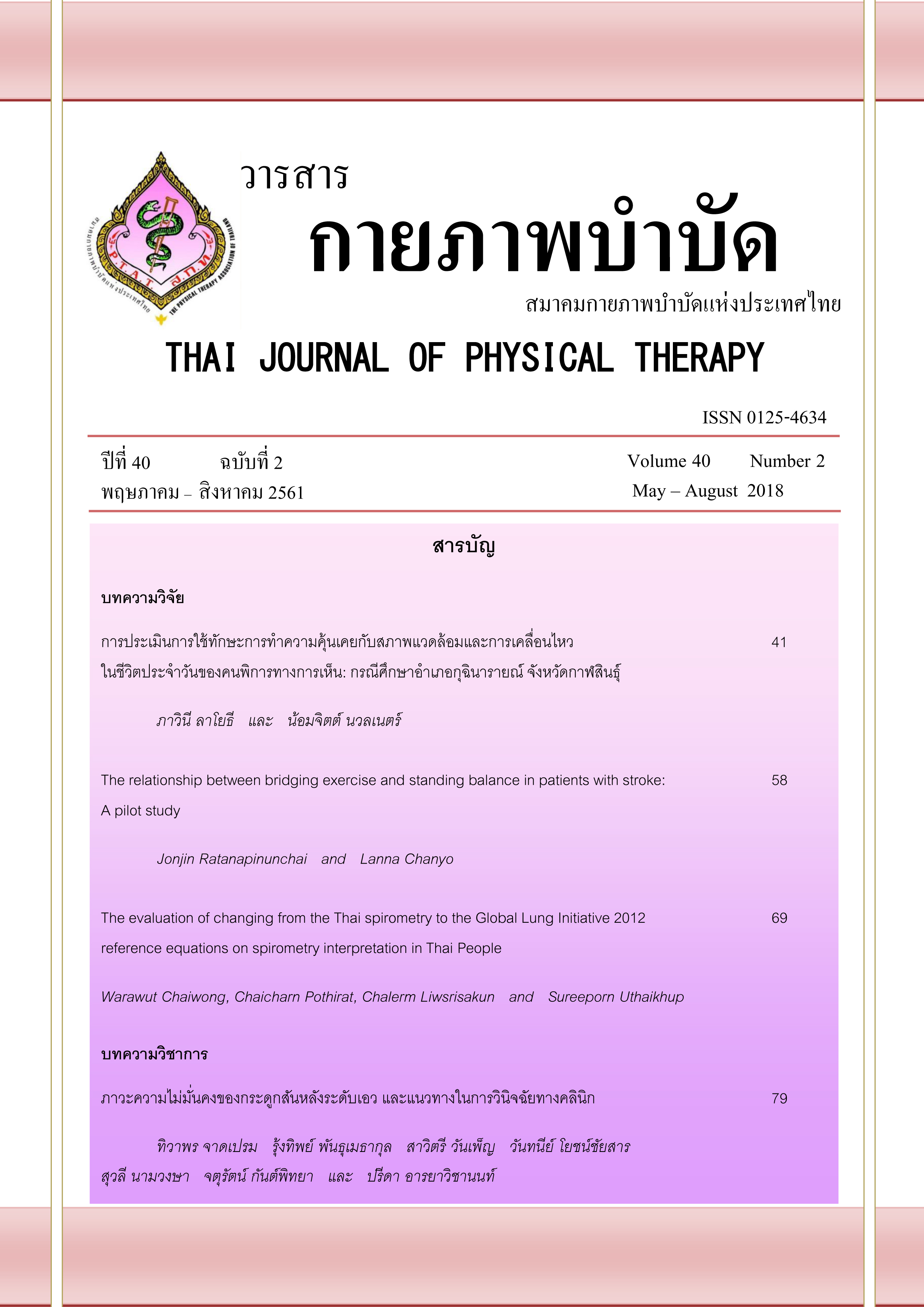ความสัมพันธ์ระหว่างการบริหารท่าสะพานโค้งกับการทรงตัวในท่ายืน ในผู้ป่วยโรคหลอดเลือดสมอง: การศึกษานำร่อง
Main Article Content
บทคัดย่อ
ที่มาและความสำคัญ: ท่าบริหารสะพานโค้ง (bridging) จัดเป็นท่าบริหารพื้นฐานที่ใช้ในการรักษาทางคลินิกในผู้ป่วยโรคหลอดเลือดสมอง ปัจจุบันยังไม่มีการศึกษาเกี่ยวกับความสัมพันธ์ระหว่างการบริหารท่าสะพานโค้ง กับความสามารถในการทรงตัวในท่ายืนของผู้ป่วยโรคหลอดเลือดสมอง
วัตถุประสงค์: เพื่อศึกษาความสัมพันธ์ระหว่างการบริหารท่าสะพานโค้ง กับความสามารถในการทรงตัวในท่ายืนของผู้ป่วยโรคหลอดเลือดสมอง
วิธีการวิจัย: การศึกษานี้เป็นการประเมินผลเชิงตัดขวางในอาสาสมัครที่มีโรคหลอดเลือดสมอง จำนวน 25 คน แบบทดสอบความสามารถในการบริหารท่าสะพานโค้ง มี 5 คะแนน และแบบทดสอบความสามารถในการทรงตัวในท่ายืนมี 9 คะแนน ได้ถูกประยุกต์ขึ้นโดยอาศัยข้อมูลจากการศึกษาที่ผ่านมา ลำดับของการทดสอบกำหนดโดยการสุ่ม
ผลการวิจัย: อาสาสมัครสามารถทำท่าสะพานโค้งได้คะแนนเฉลี่ยในระดับ 2.28±0.79 คะแนน (ค่ากลาง = 2) และมีความสามารถในการทรงตัวในท่ายืน 5.00± 2.12 คะแนน (ค่ากลาง =6) และพบว่ามีความสัมพันธ์กันในเชิงบวกระหว่างการบริหารท่าสะพานโค้งกับความสามารถในการทรงตัวในท่ายืนของอาสาสมัครที่มีโรคหลอดเลือดสมอง ในระดับสูง (r = 0.876, p <0.01) นอกจากนี้ การบริหารท่าสะพานโค้ง ยังสามารถทำนายความสามารถในการทรงตัวในท่ายืนของอาสาสมัครได้ถึงร้อยละ 77
สรุปผล: สำหรับผู้ป่วยโรคหลอดเลือดสมองที่มีการทรงตัวในท่านั่งดี นักกายภาพบำบัดอาจทำนายความสามารถในการทรงตัวในท่ายืนจากความสามารถในการทำท่าสะพานโค้งของผู้ป่วยได้ อย่างไรก็ตาม การนำผลการศึกษาไปใช้ทางคลินิกต้องกระทำตามเงื่อนไขที่กำหนดไว้ในการประเมินท่าสะพานโค้งและการทดสอบการทรงตัวในท่ายืน
Article Details
เอกสารอ้างอิง
2. Ryu Y, Ju S, Park G, et al. Effects of bridging exercise methods on the muscular activity of the neck, trunk and lower limbs. J Phys Ther Sci 2011; 23: 867-9.
3. Troy L. An EMG study of the quadriceps and hamstrings during bridging. Master thesis in Sargent College of Allied Health Professions. Boston University, 1981.
4. Ishida H, Kobara K, Osaka H, et al. An electromyographic analysis of trunk and hip extensor muscles during bridging exercises-Effect of voluntary control of the pelvic tilt. J Phys Ther Sci 2011; 23: 863-5.
5. Lee SY, Lee SK. The impact of abductor and adductor contraction in a bridging exercise on muscle activities in of the abdominal region and the lower extremities. J Phys Ther Sci 2012; 24: 1095-7.
6. Ryu Y, Roh H. Cervical, trunk and lower extremity muscle activities during bridging exercise on stable vs unstable bases of support. J Phys Ther Sci 2012; 24: 585-8.
7. Garcia-Vaquero MP, Moreside JM, Brontons-Gil E, et al. Trunk muscle activation during stabilization exercises with single and double leg support. J Electromyogr Kinesiol 2012; 22: 398-406.
8. Kang H, Jung J, Yu J. Comparison of trunk muscle activity during bridging exercises using a sling in patients with low back pain. J Sports Sci Med 2012; 11: 510-5.
9. Lee SK, Moon DC, Cho HR, et al. Effects of trunk and neck extensor muscle activity on the bridging exercise according to knee joint angle. J Phys Ther Sci 2013; 24: 363-5.
10. Tsuji T, Liu M, Tsujiuchi K, et al. Bridging activity as a mode of stress testing for persons with hemiplegia. Arch Phys Med Rehabil 1999; 80: 1060-4.
11. Bobath B. Adult hemiplegia: Evaluation and treatment. London: Butterworth-Heinemann, 1990.
12. Sullivan PE, Markos PD. Clinical procedures in therapeutic exercise. Norwalk, Connecticut: Appleton & Lange, 1996.
13. Song G, Heo J. The effect of modified bridge exercise on balance ability of stroke patients. J Phys Ther Sci 2015; 27: 3807-10.
14. Lim OB, Kim KS. Effects of different knee flexion angles according to three positions on abdominal and pelvic muscle activity during supine bridging. Phys Ther Kor 2013; 20: 1-8.
15. Ekstrom RA, Donatelli RA, and Carp KC. Electromyographic analysis of core trunk, hip and thigh muscles during 9 rehabilitation exercises. J Orthop Sport Phys 2007; 37: 754-62.
16. Kim JH, Kim Y, and Chung Y. The influence of an unstable surface on trunk and lower extremity muscle activities during variable bridging exercises. J Phys Ther Sci 2014; 26: 521-3.
17. Jang EM, Kim MH, Oh JS. Effects of a bridging exercise with hip adduction on the EMG activities of the abdominal and hip extensor muscles in females. J Phys Ther Sci 2013; 25: 1147-9.
18. Park HJ, Oh DW, Kim SY. Effects of integrating hip movements into bridge exercises on electromyographic activities of selected trunk muscles in healthy individuals. Man Ther 2014; 19: 246-51.
19. Richardson DLA The use of the tilt table to effect passive tendo-Achilles stretch in a patient with head injury. Physiother. Theory Pract 1991; 7: 45-50.
20. Hamzat TK and Fashoyin OF. Balance retraining in post stroke patients using a simple, effective and affordable technique. Afr J Neurol Sci 2007; 26: 39-47.
21. Judge JO, Lindsey C, Underwood M, et al. Balance improvements in older women: Effects of exercise training. Phys Ther 1993; 73: 254-62.
22. Verheyden G, Vereeck L, Truijen S, et al., Trunk performance after stroke and the relationship with balance, gait and functional ability. Clin Rehabil 2006; 20: 451-8.
23. Verheyden G, Ruesen C, Gorissen M, et al. Postural alignment is altered in people with chronic stroke and related to motor and functional performance. J Neurol Phys Ther 2014; 38: 239-45.
24. Berg K, Measuring balance in the elderly: Validation of an instrument [Dissertation]. Montreal, Canada: McGill University, 1993. cited from Shumway-Cook A, Woollacott M. Motor Control: Theory and practical applications. Baltimore: Williams & Wilkins, 1995.
25. Hellstrom K. On self-efficacy and balance after stroke. Clin Rehabil 2002; 17: 55-65.


